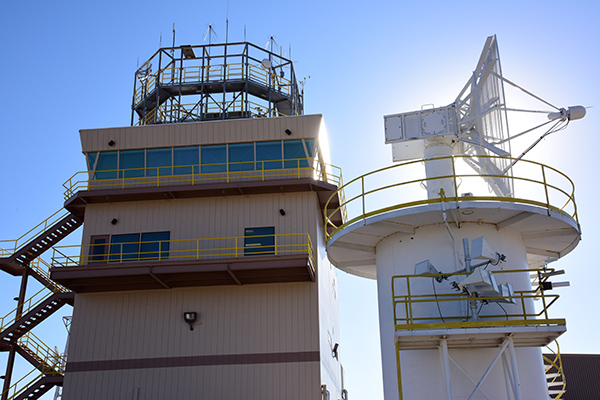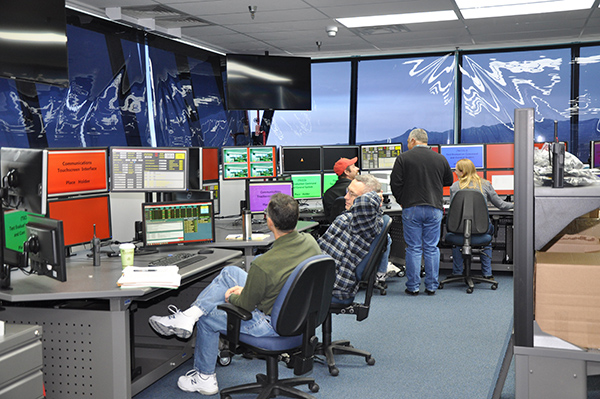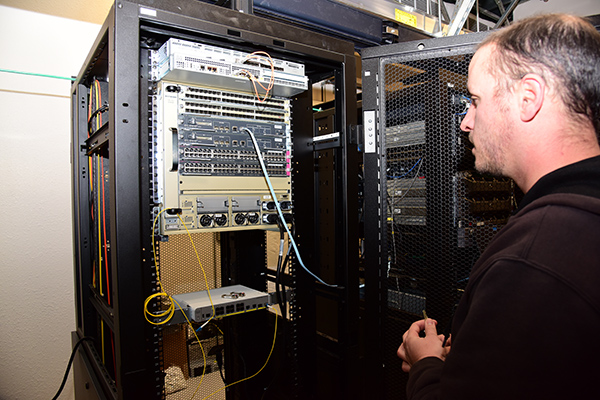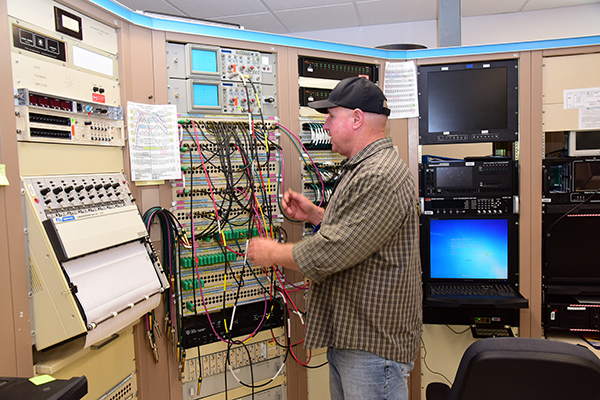Tonopah upgrades help Sandia testing

A former test director at Sandia’s Tonopah Test Range once described its combination of old and new tracking and data-collection equipment as like a mix of horseless carriages and horses — you can’t feed oats to the horseless carriages and you can’t gas up the horses.
It’s been a challenge for Tonopah to keep decades-old equipment running while gathering the detailed information required for 21st century non-nuclear testing. Over the past several years, the 60-year-old Nevada range has changed the analog brains in instruments to digital, moved to modern communications systems, upgraded telemetry and tracking equipment, and updated computing systems.
Tonopah is the test range for programs that extend the life of the nation’s aging nuclear weapons arsenal. The heart of the range’s far-flung network for tracking and gathering data is the telemetry ground station. Tonopah has two: a primary ground station at the control tower with three antenna dishes and a mobile telemetry trailer with a single antenna dish close to a target area.
“Two years ago we did not have this real-time telemetry capability. It is phenomenal.”
More recently, the range added the ability to pipe telemetry data during tests back to Sandia/Albuquerque in real time. First demonstrated in April 2015, it was enabled by Sandia’s copyrighted Telemetry Analysis and Visualization Suite software. Team members in Albuquerque not only received the telemetry data during a March flight test, but saw the same displays of information from various subsystems shown at Tonopah and heard the audio from the control tower.
“That was great,” said Gary Sanders, now-retired vice president of Weapons Engineering & Product Realization. He and other Albuquerque listeners heard reports of the plane taking off, its test passes over the range, and the test director checking in with system operators and range safety. “Plus we had knowledgeable people who told us about the test parameters and what we would be able to see on each telemetry screen. So we were able to watch each of the systems function, which I had never seen before. Two years ago we did not have this real-time telemetry capability. It is phenomenal.”

Eventually: video stream to Sandia Albuquerque
Tonopah took the first step toward the feed a few years ago by delivering still shots from a test to Albuquerque. Eventually, Sandia expects near real-time, fully integrated communications telemetry, including videostream to Albuquerque.
Improvements mean better information processing and more flexibility in accessing and using that information, says Joseph Hasekamp (2324), B61-12 Joint Test Assembly test lead. He’s responsible for coordinating, planning, and executing tests associated with the B61-12 JTA, which contains only non-nuclear components.
“We can see the data remotely, which gives us better access to Tonopah,” he says. “I can sit here in my office in Albuquerque and participate in the range checkout in Tonopah,” a process that tells engineers that systems are functioning in advance of a test.
“It’s one of those situations where we didn’t know how much better we could do our jobs until we had the capability,” Joseph says. “It allows us to do our jobs more efficiently and precisely. It gives us better information and saves taxpayer dollars.”
“We didn’t know how much better we could do our jobs until we had the capability.”
Gary Ashcraft (2662) says the B61-12 program began using the Telemetry Analysis and Visualization Suite software during telemetry system development and continued using it through ground testing and finally during flight tests and their analysis. “That system development lifecycle support is a key capability of TAVS, and it enables the test-like-you-fly and fly-like-you-test mantra of Org. 2660,” he says.
Telemetry stations gather radio frequency emissions from mock weapons being tested or the airplanes that carry them. Other instruments throughout the 280-square-mile range, including optical tracking telescopes and radars, follow a test unit during flight.

Basic systems haven’t changed, needs have
Basic telemetry systems haven’t changed much in three decades, but the required data rate has, says Sandia/California’s Gary Kirchner (8735), a telemetry expert who travels to Tonopah every couple of months for tests. Telemetry receivers around since the 1980s can perform at up to 2 megabits per second — but today’s tests need data rates of 5 megabits.
“Once the data rates for the B61-12 program were determined, it was clear that all current instrumentation needed extreme maintenance or upgrades,” Gary says. Tonopah replaced recorders, receivers, source selectors, amplifiers, antenna feed assemblies, and hundreds of radio frequency and coaxial cables as well as monitors and other equipment in its four-story Test Operations Center at Sandia’s compound. Most of the equipment replaced was more than 30 years old.
Data tape recorders went first, since magnetic tape was quickly becoming obsolete. Upgrades began in 2007-2008 with six telemetry receivers and four first-generation digital telemetry recorders, one since superseded by a newer generation.
The project replaced four analog reel-to-reel recorders that had 15 minutes of recording time. Mark Skobel (2235), who runs Tonopah’s telemetry operations, says new hard-drive technology provides faster recording and greater storage. It can record 16 analog and 16 digital channels and archive dozens of missions.
Updated receivers and related equipment increased bandwidth and improved data quality. Mark, who began working in telemetry in 2011, says the higher data rates allow engineers to more quickly analyze output from sensors, while other upgrades offer greater detail for analyses. Tonopah installed additional telemetry receivers between 2013 and 2015.
Numerous Tonopah systems upgraded
Three years ago, Tonopah replaced its mobile telemetry trailer with one that has a new antenna system, six telemetry receivers, a telemetry recorder, and ancillary equipment.
About the same time, the range refurbished two tracking antenna dishes at the compound, replaced two antenna control units, and acquired a mobile backup system that eventually will be moved to the range’s east side for better overall reception.
The control room now features dozens of flat-screen color computer monitors that display detailed tracking information — real-time video of tests and telemetry data fed from Tonopah’s Range Acquisition and Control System tracking computers and Test Evaluation Command and Control System. The modern tools replaced black and white screens and analog, push-button equipment so old that range test director Joe Simile (2235) felt he’d stepped back in time and “thought I’d look out and see a Mercury capsule” from NASA’s 1960s-era program.
Construction projects in the tower three years ago and last year “got rid of the old stuff and went digital,” replaced wiring and communications links, and rid the tower of asbestos hazards, Joe says.

The research and development team of Stephanie Shreck (2251), Steve Ohrt, Richard Crowder, and Dave Flegel (all 2235) upgraded, integrated, and validated new systems and closed interoperability gaps that emerged in folding new equipment into a long line of legacy systems.
Just last year, workers installed miles of fiber-optic cable around the vast range.
Upgrades extend to field equipment as well. Analog innards have been swapped for digital in Tonopah’s cinetheodolites or cines, combination photo-recording and surveying instruments that look like miniature astronomy observatories and track and photograph targets. Joe says cines were converted two years ago as manufacturers phased out film. In the meantime, Tonopah bought all the film and film-processing chemicals possible so cines could keep shooting until converted.
A 1950s-era tracking telescope built at Sandia’s long-gone foundry on top of an old Navy gun turret looks much like it did originally. But inside, its hydraulic drive has been replaced with a DC drive control system and new high-speed digital camera, says Glen Watts (2235), Tonopah’s technical team lead. The operator in the seat now uses a laptop, joystick, and touch-screen monitor to operate the 117-inch-long telescope.
By fall, the operator on the mount will be gone as well. Tracking equipment now handled by operators at field sites will be controlled by a remote operator at the Test Operations Center.